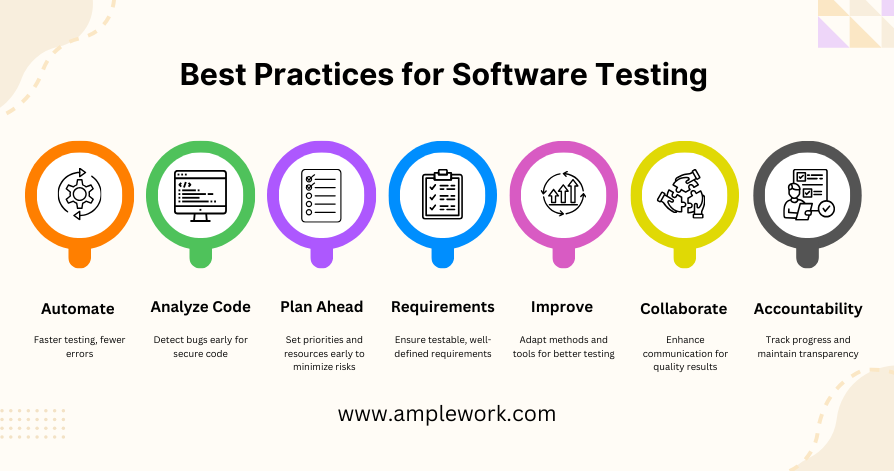Software Testing Methodologies Guide: An In-Depth Overview
Table of Contents
In today’s prototype development landscape, the success of any product depends largely on the quality of its testing. Testing ensures that properly functioning products are safe, reliable, and able to say goodbye to real-world problems. Moreover, without tests, companies experience limited improvement, missed deadlines, and damage to their reputation.
This is how software testing has improved over time. In earlier practices, testing was done after the development stage, and it would delay and problems happen on the later side of the process. Now testing is performed at every development phase to detect problems early, save costs, and enhance product quality. Businesses can provide faster delivery with a more reliable product to customers by applying different testing methods like functional, performance, and security testing throughout the lifecycle.
This blog explores what testing methodology in software testing entails, the different approaches available, and their importance in modern development. Whether you’re working with agile processes, DevOps, or traditional methods, understanding the right software testing methodologies and their practical applications is crucial.
What Is Software Testing?
When searching for top-tier software methodology it’s crucial to understand What is software testing, cause it will help you grasp software testing methodologies better. So, software testing analysis is a software product, or in simple terms you could say checking an app. This encompasses checking whether it’s working right or not, as well as whether there are any gaps or errors between the actual behavior that you are expecting from the tech product and the expected outcome. These steps eventually help to make sure that the software product is reliable and secure.
Through methodical analysis, software testing seeks to uncover bugs, ensure alignment with design specifications, and confirm that the product meets all defined requirements. By identifying and resolving issues early in the development process, testing prevents expensive fixes, delays, and potential harm to user trust or the company’s reputation.
In a nutshell, software testing guarantees that a product functions as expected under standard conditions while also handling edge cases and unforeseen scenarios safely and effectively. This ensures that the software is suitable for its intended purpose, providing both functionality and security to the end user.
What Are Software Testing Methodologies?
The software testing methodology is a highly specialized, implementation-oriented approach and strategy to evaluate a particular product or application software. The product or application software should meet the predefined performance and provide an assessment of its correct functioning for utilization by the user. Through these methodologies, the product is tested on all aspects and properties that need to be evaluated, defects are identified earlier, and the product, in the end, should be of high quality. These methodologies are used to enhance software performance and reliability, making it secure and ultimately ensuring its successful release.
Top Software Testing Methodologies
With the above concept of software testing methods, let’s move to the most efficient methods. These testing techniques improve software quality besides helping companies scale, improve user satisfaction, and be competitive in the market.
Performance Testing
Performance testing is one of the most significant techniques in software testing. It checks the performance of a system under various conditions such as load, stress, and scalability. This ensures that the application can handle the expected traffic and will work well under pressure. It also checks if the system can scale as needed. Identifying issues helps optimize resources and improve speed, which means that the application would be smooth to use.
Security Testing
Security testing is an important software testing technique that detects faults and guards against attacks. Such applications include, for instance, banking or medical apps, for which security is paramount to avoid cyberattacks and data breaches. Security testing helps avoid security-related errors that can harm the company’s reputation or undermine customer confidence by ensuring that the software works with security requirements and safeguards user data. This is an essential testing method when security is paramount.
Integration Testing
Integration testing seeks to confirm if several systems or components interact as expected. Usually used following unit testing, this approach guarantees proper integration of many parts of the software internal APIs or outside integrations. By preventing issues at the moment of module interface, it guarantees flawless data flow and general system functionality.
Unit Testing
Unit testing aims at checking out the single parts or units of code, in which every developer will perform such tests at the coding phase itself. They make sure each function or method is correct before implementing it. This can prevent errors as soon as they begin in the development process and therefore ease debugging with improved overall code quality. This is one of the core methods in software testing for ensuring the reliability of the code.
Agile Methodology
The agile technique is all about taking little moves, remaining adaptable, and responding rapidly to change. It focuses on cooperation and frequent updates through short development cycles called as sprints. This strategy ensures that the project remains on track with user needs and business objectives while allowing for constant input. Agile is suitable for projects that move quickly and whose requirements may change over time, as it stresses frequent changes and rapid releases.
Waterfall Model
Waterfall methodology is one of the most used technical methodologies. This approach requires phases to be completed first then moving on to the next one in software development. It is ideal for projects that have pre-defined requirements and contain no expected changes. This software testing methodology is being used by sectors like government, healthcare, and many more. Waterfall methodology even though it provides a clear, structured process; however, lacks flexibility in case of changes that sometimes require changes during the project. Furthermore, this is unlikely to correspond with today’s rapidly changing technological world. Consequently, it continues to be a well-recognized testing methodology, notwithstanding its inherent limitations.
Manual Testing
Manual testing is a type of software testing method that is performed by human testers without the support of automation tools. This method is very useful in testing complicated features that are difficult to automate and exploratory and usability testing. Manual testing is slower than automated testing. However, it is necessary for tasks that need human judgment and intuition. This includes evaluating user interfaces and experiences. For subjective tasks, manual testing is essential.
Automated Testing
Automated testing is one of the most well-known software testing techniques. This helps minimize overall human involvement using the utilization tools and also different kinds of scripts to run predetermined test cases. This software testing method is ideal for regression testing, repetitive tasks, and also for applications that are under testing and require frequent updates. Therefore, this method of testing speeds up the overall testing process increases coverage, and many more. As a widely used software testing method it helps reduce testing time drastically by requiring less investment in tools and scripting setups.
Smoke Testing
Smoke testing is actually the introductory test for software’s basic functionality to determine whether there is any fatal flaw. This is carried out at the initial high level of testing to ensure that the software build is stable in order to conduct further testing. While analyzing critical issues, smoke testing saves the effort of wasting resources and time in the development cycle.
White Box Testing
White box testing is software internal structure and logic analysis. Basically this software method is carried out by developers, it emphasizes code logic, flow, and security, thereby helping to find flaws, bugs, or inefficiencies in the codebase. This software technology not only improves code quality but also increases software resistance to possible security risks.
Compliance Testing
Compliance testing guarantees that software adheres to legal, industry, and standard regulations. It is especially critical in industries such as finance, healthcare, and telecommunications, where breaching the rules can result in severe legal or financial consequences. This testing ensures that the product meets all legal criteria, which protects both the product and its users.
Beta Testing
Beta testing is distributing the program to a chosen set of outside users to get comments and find any flaws and this is one of the best software technology. Also, Conducted following alpha testing, it offers insightful analysis from actual users in various contexts, therefore guaranteeing that the program satisfies user requirements prior to an official release. This stage is absolutely essential for exposing problems that might not show up in internal testing.
Compatibility Testing
This is another important type of software testing method. Compatibility testing ensures that the program runs as intended on many devices, operating systems, and browsers. Overall, Web and mobile apps depend on this kind of testing to provide a constant user experience independent of the platform or environment. It also points up and resolves possible problems using outside tools or integrations.
Stress Testing
Stress testing evaluates the software’s performance under extreme or abnormal conditions, such as high traffic or low system resources. This process identifies how well the system handles stress and recovers from failures, ensuring reliability during unexpected situations. It also highlights the software’s limits, guiding teams to implement better fail-safe mechanisms.
Maintenance & Regression Testing
Software updates, patches, and changes should not break the current functionality; that’s why regression testing and maintenance are very important. In the long term, this ensures the stability and dependability of the product by watching for any repeated occurrence of past bugs and ensuring that new features run flawlessly. This testing is key to maintaining user confidence and satisfaction with the product.
What are the Advantages of Software Testing Methodologies?
Software testing methodologies improve software quality, help detect problems early, reduce costs, and ensure customer satisfaction. By integrating testing into every stage of development, organizations can ensure more reliable and efficient products, ultimately achieving faster time-to-market and risk mitigation. So, let’s discuss the benefits of software testing methodologies.
1. Improved Software Quality
However, by adopting a structured testing methodology, the software is thoroughly tested right from the development stage. Testing methodologies ensure that the final product becomes of expected quality as possible defects are caught in the early stages, thereby giving users a more reliable and bug-free experience.
2. Defect Detection Early
Software testing methodologies, especially Agile or Test-Driven Development (TDD), focus on continuous testing. This way, teams can identify and correct errors at the early stages of development, thus avoiding major problems later in the project.
3. Cost Efficiency
Early detection of bugs through consistent testing significantly lowers the cost of fixing problems. The longer it takes for the defect to be noticed, the more costly the time becomes to correct it. Structured methodologies help stay within these costs by catching problems at the most cost-effective state.
4. Increased Customer Satisfaction
Thoroughly tested software functions as expected, thereby reducing user complaints and enhancing the user experience. Testing methodologies contribute to higher customer satisfaction and retention by ensuring that the software is free of defects and performs well.
5. Clear Documentation and Traceability
Testing methodologies often require detailed documentation of test plans, results, and progress. This documentation provides a clear record of the testing process, allowing for better traceability, accountability, and understanding of how the software evolves.
6. Risk Mitigation
An early risk identification through a structured testing approach ensures the risk is identified early in the development cycle. In most cases, catch-bug testing methodologies ensure developers are proactive regarding controlling risks that might develop further, leading to a reduced risk of a delay-prone project.
7. Faster Time-to-Market
Integration of testing in all the phases of development makes sure that teams find problems in the early stages, thus taking much less time to fix the bugs post-release and thus bringing faster products into the market to have a better lead over businesses in the market.
What are the disadvantages of Software Testing
As we have discussed the advantages of software testing, let’s now focus on the disadvantages. Here are the potential drawbacks of the software testing:
- Time-Consuming: Software testing can be a time-consuming process, especially when trying to cover all possible scenarios. This can delay the development timeline, impacting deadlines and project delivery.
- High Costs: Thorough testing, which might involve manual or automated methods, is expensive. The cost of hiring good testers, tools, and infrastructure weighs heavily on project budgets, more so for small projects.
- Limited Coverage: Comprehensive coverage can never be realized in that tests cannot be designed to test every single possible scenario for large and very complex software systems. There might be bugs, which may evade detection.
- False Positives/Negatives: Sometimes, tests will incorrectly report the presence of a problem (false positives) or miss real problems (false negatives). This wastes time or causes critical defects to be overlooked.
- Dependence on Test Environment: The testing environment is not likely to reproduce real-world conditions very closely. Most of the test results and the realities after the deployment are different.
- Resource Intensive: Testing is very resource-intensive; this means, for instance, a lot of human and technology resources. This might result in losing focus on other key features or innovation development.
- Diminishing Return: The law of diminishing return applies as well in testing, especially at extensive complex systems where the cost to detect a new bug is relatively high and a smaller number of new bugs are discovered. This concept brings out the idea of the idea of getting less relative value for additional effort.
Best Practices for Software Testing
Effective software testing is the key to quality and reliability. Following best practices in the software testing lifecycle can help teams find issues early, improve efficiency, and deliver better products. So, let’s explore:
1. Automate for Efficiency
Automation will help to make the process more efficient and fast. Repetitive tasks will be automated so that the teams can work on complex and critical aspects of the application. The automated testing tool will enable a faster execution of test cases and reduce human error, with results being more consistent. It will also enable continuous integration so that releases happen quickly and there are more frequent updates.
2. Use Code Analysis Tools
Code analysis tools help detect potential issues at an early stage of the development cycle. It helps analyze the codebase for bugs, vulnerabilities, or inconsistencies, thus giving valuable insights to prevent defects from slipping into production. Static and dynamic code analysis can assist in maintaining high-quality standards and ensuring the code is maintainable and secure.
3. Plan Early
Early initiation of testing is critical to the success of any project. Early planning allows teams to clearly define what they would want to test, set priorities on which test cases are important to test and get resources right. Knowing requirements and possible challenges early on helps testing better organize its efforts toward achieving project objectives. Strategic planning also knocks away potential risks at levels before they happen.
4. Definable Testable Requirements
Testable requirements form the basis of any successful testing effort. Clear and well-defined requirements ensure that test cases can be created to check specific functionalities. Ambiguous or vague requirements lead to misunderstandings, missed defects, and ineffectual testing. If all requirements are testable and measurable, they can be validated precisely and effectively.
5. Continuous Improvement
Software testing is a continuous process. Continuous improvement in software testing services involves refining methodologies, tools, and techniques over time through regular retrospectives, feedback loops, and past project learnings. This approach enhances team performance and ensures higher-quality software. Adaptability to trends, technologies, and challenges further improves efficiency and effectiveness in testing.
6. Encourage Team Collaboration
Effective communication and collaboration between developers, testers, and other stakeholders are necessary for successful software testing. Teams should work together to share knowledge, address issues promptly, and ensure alignment on goals. Collaborative efforts help identify potential problems earlier, streamline decision-making, and improve overall product quality. Testing is a shared responsibility that benefits from collective input.
7. Maintain Accountability
Accountability ensures that all parties in the development and testing process own their tasks and outcomes. There should be proper documentation, progress tracking, and transparent reporting for monitoring the effectiveness of testing efforts. When accountability is maintained, teams can easily identify bottlenecks, issues can be proactively addressed, and testing efforts are aligned with project timelines and goals.
Read More:- Best practices of Software Testing
How to Select the Right Software Testing Company
To select the right software testing company, it’s important to first ensure that the company meets all your specific requirements and also falls in line with the following key criteria.

1. Assess Your Testing Requirements
Define your testing needs, including the specific types of tests required (functional, security, performance). Knowing your project scope will help you identify companies with relevant expertise. Clarifying these needs from the start streamlines the selection process.
2. Evaluate Industry Experience
Look for a company with proven experience in your industry. Industry familiarity ensures the company understands specific challenges and regulations. This expertise can lead to more effective and relevant testing solutions.
3. Analyze Technical Expertise
Be sure the company has expertise in any technology used, be that testing tools or frameworks. Exposure to web, mobile, or enterprise applications provides assurance that they are at least able to handle your project’s complexity. Their technical competency should meet your needs.
4. Verify Certifications and Standards
Select a company that is compliant with industry standards and certifications. These certifications indicate a commitment to quality and adherence to process. Certified companies use proven methodologies, which ensure consistent testing results.
5. Proven Methodologies
The testing company should have structured methodologies, which include both manual and automated testing. They should also use best practices in continuous integration and delivery. Well-defined processes lead to thorough and reliable testing outcomes.
6. Review Client Testimonials and Case Studies
Check reviews and case studies to evaluate the company’s past success. A company with a strong track record in software testing services will have positive feedback and proven results.7. Consider Communication and Collaboration
Select a company that is agile and communicative. Communication should be kept very smooth to provide regular updates on progress and transparency in the processes followed. Good collaboration ensures alignment and smoother execution of testing.
Why Choose Amplework for Software Testing?
Amplework promotes quality in software development through rigorous testing processes. Our developers, knowledgeable in artificial intelligence software testing services, use a variety of testing techniques to catch problems early on and fix them before they get to users. By utilizing Agile and Test-Driven Development, we ensure that each stage of the development process is completely tested. This results in a dependable and durable solution that meets both functional and performance requirements, ensuring a consistent user experience.
Along with quality, Amplework prioritizes cost savings and faster time-to-market. Identifying and resolving faults at an early stage reduces the cost of subsequent fixes. Our standardized software testing services process not only eliminates risks but also shortens the whole development cycle, allowing you to meet obligations swiftly without sacrificing quality. Using unambiguous annotations and traceability, we ensure transparency throughout the process, giving both security and a solution that matches your needs.
The implementation of high-quality, robust software through effective software testing is crucial to ensuring reliability and performance. When you choose Amplework, you gain access to our expertise in early detection, cost efficiency, and quicker time-to-market. Our methodology ensures rigorous testing, reduced risks, and a product that reaches its maximum potential. As a trusted software testing company, we focus on quality, transparency, and customer satisfaction, ensuring the best project delivery time after time.
Related Blog:- Difference Between software Testing and Quality Assurance
Conclusion
Software testing methodologies are critical for the quality and performance of the application. This can be done through the early detection of bugs and vulnerabilities in the development process so that reliable and user-friendly software can be delivered. The approach is either manual, automated, or continuous integration and has unique benefits for optimizing the testing process. The choice of methodology for a project depends on the scale, complexity, and timeline of the project. However, a good testing strategy is crucial in reducing risks, improving customer satisfaction, and maintaining long-term software performance.
Due to the use of sophisticated testing techniques, Amplework Software produces accurate and free-of-error applications. Our expert team employs a combination of manual and automated testing techniques to ensure every aspect of your software is meticulously verified. Through the incorporation of QA best practices, we contribute to preventing problems early on to reach the users without impacting them so that minimal downtime can be achieved and the user experience can be improved. Working with Amplework, clients can achieve faster time-to-market, cost-effective outcomes as well as scalable, future-ready software that conforms to the highest industry standards. Trust Amplework Software to handle your testing needs and deliver seamless, reliable solutions.
FAQ
1. What are software testing methodologies?
Software testing methodologies refer to systematic approaches and techniques that evaluate the functionality, performance, and quality of software. Some of the common methodologies are Agile, Waterfall, V-model, and iterative. Every methodology has defined specific processes for test planning, design, execution, and maintenance to ensure that the software meets the requirements and functions properly.
2. What is Agile testing methodology?
Agile testing is integrated with Agile development, with an emphasis on collaboration and adaptability. Testing occurs in short, iterative cycles (sprints), ensuring immediate feedback. Testers work closely with developers to continuously verify software. It supports automated and manual testing, thereby increasing efficiency and product quality during development.
3. How does the Waterfall testing methodology work?
Waterfall testing is a linear approach by following requirements, design, and then implementation, followed by verification and maintenance. Testing after development begins, based on the fact that no phase can be overlapped. Though quite rigorous, it can be applied to projects having clear fixed requirements but offers lesser flexibility in case of change in the developmental stages.
4. What is the V-model in software testing?
The V-model (verification and validation model) combines the development and testing phases. Every development phase has a counterpart testing phase. For instance, acceptance testing validates the requirement. This way, errors can be identified well in advance, making the V-model suitable for high-quality, structured software projects concerning quality.
5. What is iterative testing?
This is a model of iterative development with the building and testing of software that happens in multiple cycles. More features or changes undergo strict tests as they appear in each cycle, thus removing defects and taking requirements. This way, it has more functionality as time goes on.
6. How does the spiral model support testing?
The spiral model combines iterative development and risk assessment. Testing was part of every phase of the development spiral, which addressed risks early. This type of model is best suited for complex projects with changing requirements because it overemphasizes thorough testing, user feedback, and risk aversion at each stage of the development process.
7. What is black box testing?
Black box testing tests the software without any knowledge about its internal code. Testers are only focused on inputs and outputs and have to ensure that functionalities meet specifications. It is good for user acceptance testing, functional testing, and system testing in which emphasis lies on what it does, rather than how it works.
8. What’s the difference between white box testing and black box testing?
White box testing checks the internal structure, code, and logic of the software. Testing requires programming knowledge to design test cases that assess the code paths and logic errors. It is opposite to black-box testing because it focuses on how the software works internally to ensure the accuracy and robustness of the code.
9. What is regression testing in software methodologies?
The process ensures that newly developed updates or changes in the software do not cause errors or break functionality. In retesting affected areas, this methodology will help to ensure that software remains stable; thus, it’s crucial for projects with high rates of update or iteration in development cycles.
10. What is the process of automation testing methodology?
Automation testing applies tools and scripts that are used automatically to execute test cases. This boosts efficiency, accuracy, and coverage of test cases, especially in repetitive or large-scale test cases. Basic tools include Selenium and JUnit. Although setup requires time, automation reduces manual effort and speeds up the test cycles.



 sales@amplework.com
sales@amplework.com
 (+91) 9636-962-228
(+91) 9636-962-228





